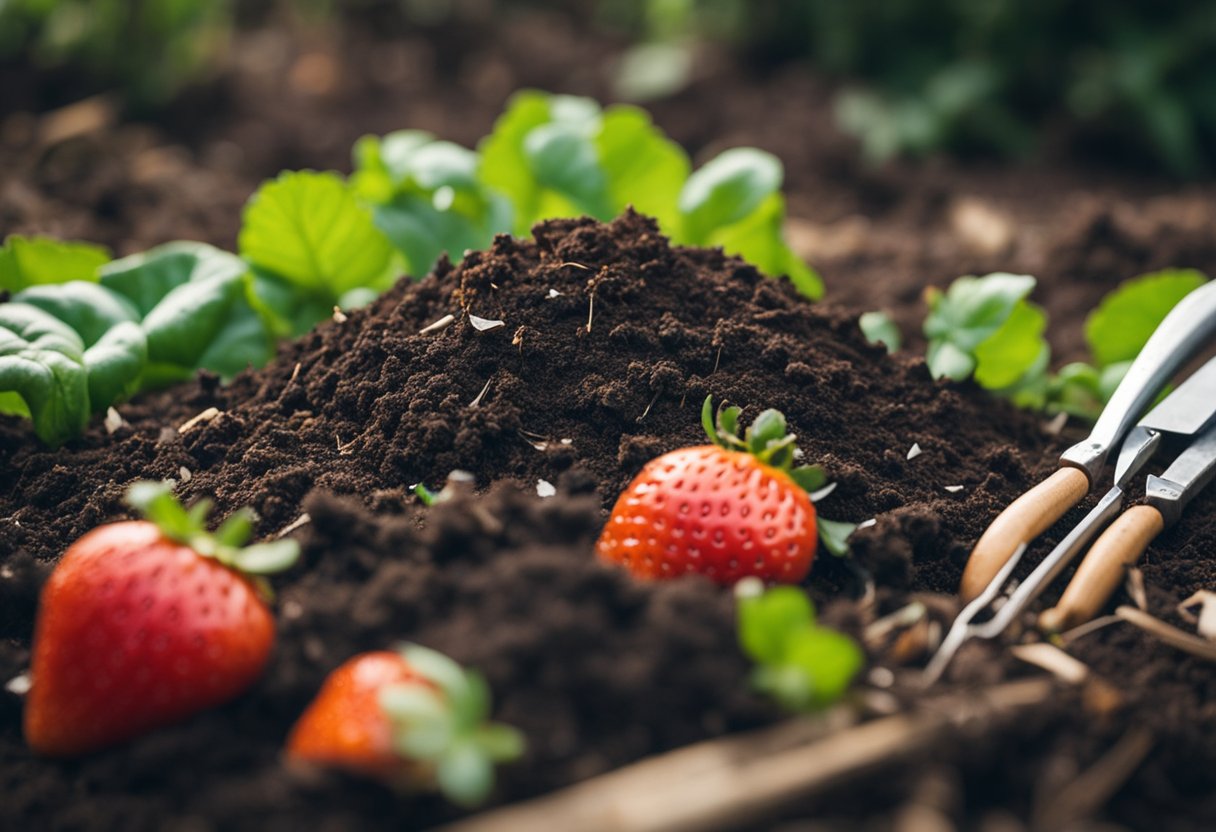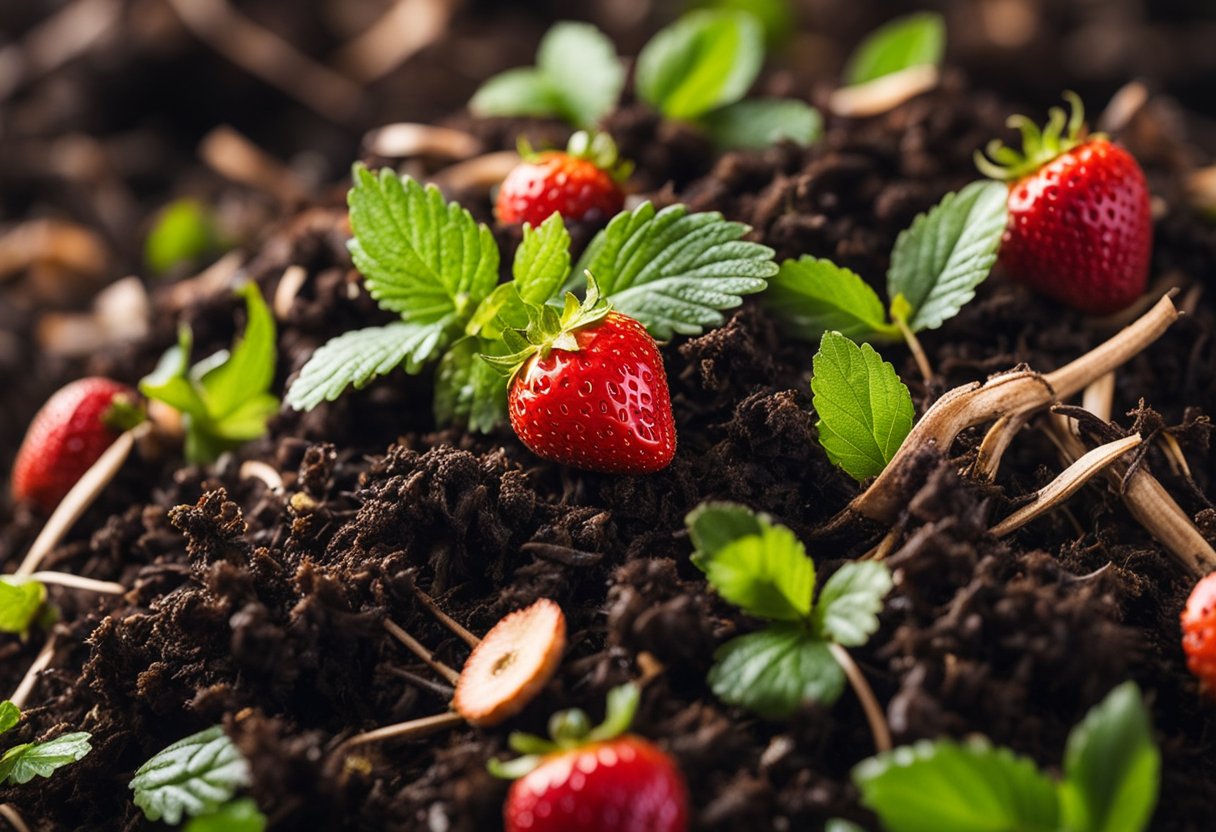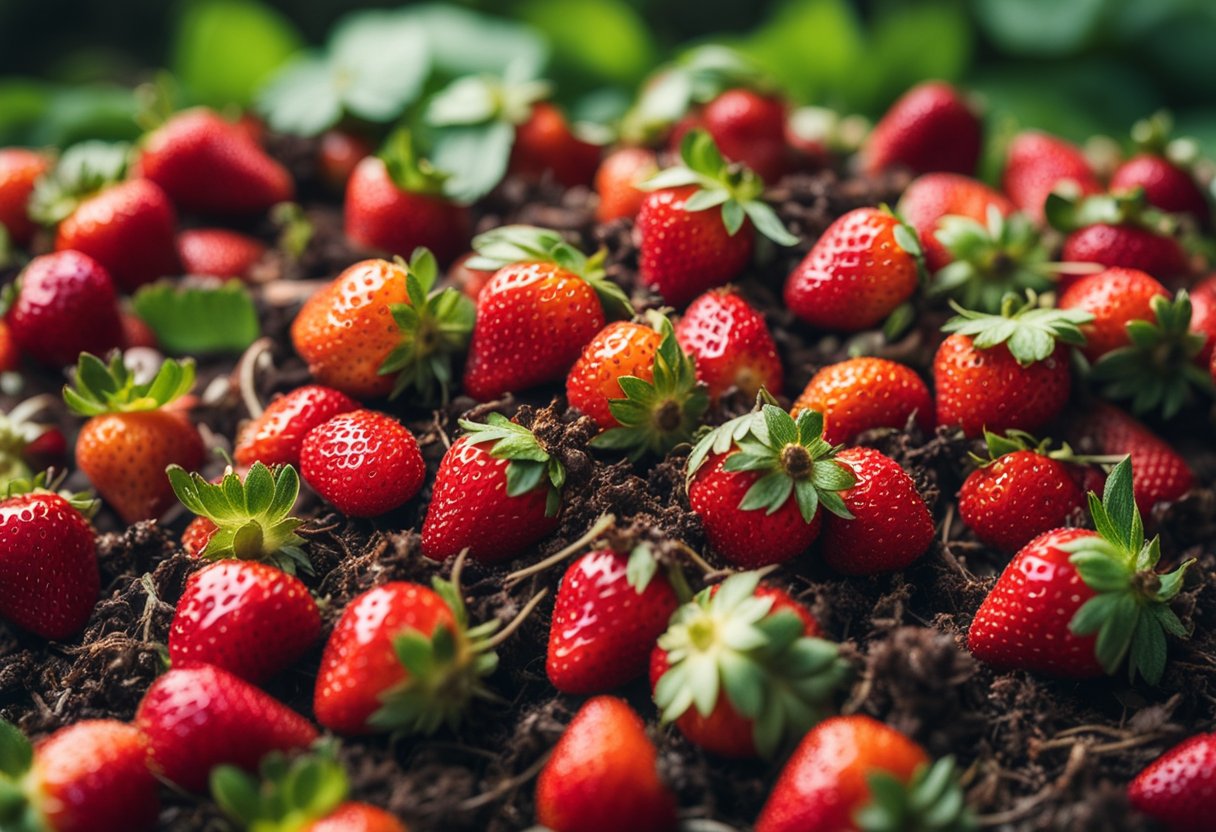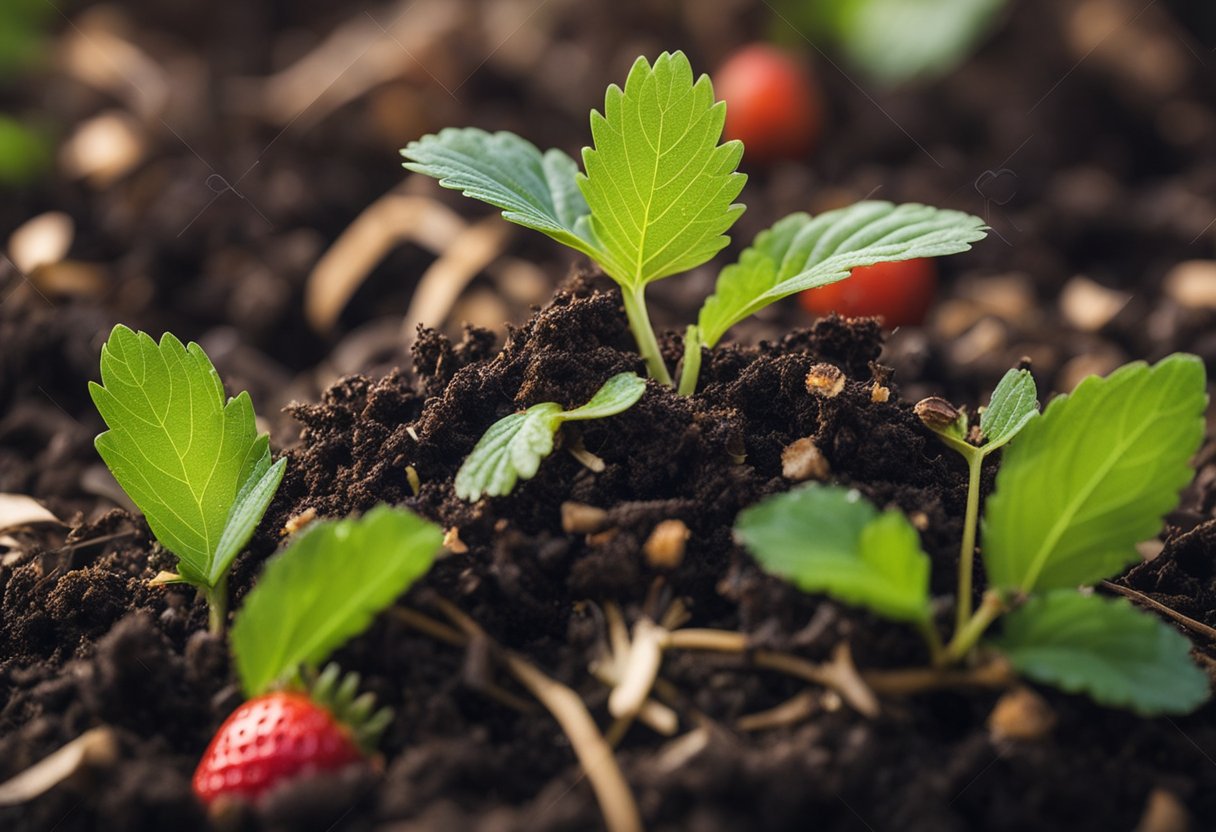As an Amazon Associate I earn from qualifying purchases.
At A Glance
Yes, you can compost strawberries. Strawberries are organic material and will decompose easily in a compost pile. They are considered “green” compost material, providing necessary nitrogen to help break down “brown” materials like leaves and twigs. If the strawberries have gone bad or if you have leftovers from your garden or kitchen, they can be a beneficial addition to your compost. It’s advisable to chop them into smaller pieces to expedite the decomposition process.
Composting is an excellent way to reduce waste and produce nutrient-rich soil for your garden. However, not all organic materials are suitable for composting, and it can be challenging to know what to include and what to leave out. One common question is whether strawberries can be composted.

The answer is yes, strawberries can be included in your compost pile. They break down quickly and easily, making them an excellent addition to your compost. However, it’s important to note that if your strawberries are rotten, they should be discarded rather than added to your compost pile. Additionally, strawberries tend to exude moisture, so it’s best to combine them with materials that absorb moisture to prevent your compost from becoming too wet.
When composting strawberries, it’s essential to be mindful of pests and animals that may be attracted to the sweet scent of the fruit. To prevent unwanted visitors, consider using a compost bin with a secure lid or burying the strawberries deep within the compost pile. By composting strawberries, you can reduce waste, improve soil quality, and grow healthy, vibrant plants in your garden.
Understanding Composting
Composting is a natural process that breaks down organic matter into a nutrient-rich soil amendment. It is a great way to reduce waste and create a sustainable source of fertilizer for your garden.
The decomposition process involves microorganisms breaking down organic materials, such as fruit and vegetable scraps, leaves, and grass clippings. Carbon-rich materials, such as straw and wood chips, are also added to provide a source of energy for the microorganisms.
Layering is an important aspect of composting. By alternating layers of carbon-rich materials and nitrogen-rich materials, such as food scraps, you can create an optimal environment for the microorganisms to thrive. The carbon-to-nitrogen ratio should be roughly 30:1 for the best results.
To maintain the decomposition process, it is important to turn the pile every few weeks to provide oxygen to the microorganisms and to ensure that all of the materials are breaking down evenly.
It is also important to wait for the compost to fully decompose before using it in your garden. This can take anywhere from a few months to a year, depending on the size of the pile and the environmental conditions.
Overall, composting is a simple and effective way to reduce waste and create a nutrient-rich fertilizer for your garden. By understanding the basics of the decomposition process and the importance of layering and turning the pile, you can create a successful compost pile that will benefit your garden for years to come.
Why Compost Strawberries

As an avid gardener, I am always looking for ways to improve the quality of my soil. One of the best ways to do this is by composting, and strawberries are a great addition to any compost pile.
When you compost strawberries, you are not only reducing waste, but you are also creating a nutrient-rich soil amendment that can help your plants grow stronger and healthier. Composting strawberries is an easy and effective way to make use of strawberry scraps and overripe fruit that might otherwise go to waste.
Strawberries are a great addition to a compost pile because they break down quickly and easily. They are considered a “green” composting material, which means they are high in nitrogen. This makes them great for balancing out “brown” composting materials, like leaves and straw, which are high in carbon.
Composting strawberries can also help improve soil structure by increasing its water-holding capacity and enhancing drainage. This results in healthier root development and overall improved plant growth.
In summary, composting strawberries is an easy and effective way to reduce waste, create nutrient-rich soil, and improve plant growth. So, if you have any strawberry scraps or overripe fruit lying around, don’t throw them away – compost them instead!
Benefits of Composting Strawberries

Composting strawberries has several benefits, both for the environment and for your garden. By composting strawberries, you can divert organic waste from landfills, which reduces greenhouse gas emissions and promotes a more sustainable environment. According to the Environmental Protection Agency (EPA), food waste is one of the largest contributors to landfills. By composting strawberries and other organic materials, you can help reduce this waste.
Strawberries are rich in essential nutrients such as potassium, phosphorus, and nitrogen. When composted, these nutrients enrich the soil, promoting healthy plant growth and productivity. The nutrient-rich compost made from strawberries can improve soil quality greatly. This organic material enhances aeration and water retention, which leads to stronger plants that may flourish due to higher moisture and nutritional levels.
Composting strawberries also helps to improve soil structure and fertility. The organic matter in the compost helps to create a fertile soil that is rich in nutrients and beneficial microorganisms. This improves soil structure, which in turn helps to retain moisture and nutrients, creating an ideal environment for plant growth.
In summary, composting strawberries has several benefits for both the environment and your garden. It reduces waste, improves soil quality, and promotes healthy plant growth. By incorporating compost made from strawberries into your garden, you can help create a more sustainable and productive environment.
Composting Process for Strawberries

When composting strawberries, it’s important to have a good mix of green and brown materials. Strawberries are considered a “green” material, so it’s important to have a sufficient amount of “brown” materials, such as dry leaves or shredded newspaper, to balance out the nitrogen content.
To start the composting process, chop or blend the strawberries into smaller pieces to help speed up the decomposition process. Once the strawberries are chopped, add them to your compost pile or bin.
It’s important to turn your compost regularly to ensure adequate aeration and to help distribute moisture and nutrients evenly. This also helps prevent anaerobic conditions, which can result in unpleasant smells and slow down the composting process.
Maintaining proper moisture levels is also important for successful composting. The compost should be damp, but not too wet. If the compost is too dry, add water. If it’s too wet, add more dry materials.
Temperature is also an important factor in the composting process. The ideal temperature range for composting is between 120-160°F (49-71°C). This temperature range helps to kill off any harmful pathogens and accelerates the decomposition process.
Finally, it’s important to ensure adequate drainage and flow of air in your compost pile or bin. This helps prevent waterlogging and ensures the compost has enough oxygen to support the decomposition process.
By following these steps, you can successfully compost strawberries and create nutrient-rich soil for your garden.
Choosing the Right Compost for Strawberries
As a gardener, I know how important it is to choose the right compost for my plants. When it comes to strawberries, there are a few things to consider. First, it’s important to choose a compost that is rich in nutrients. Strawberries require nitrogen, phosphorus, and potassium, as well as other minerals, for healthy growth and fruit production.
One option is to use compost made from garden waste, such as grass clippings, dead leaves, and other organic matter. This type of compost is rich in nutrients and can be a great choice for strawberries. Another option is to use compost made from animal manure, such as cow or chicken manure. These types of compost can be high in nitrogen and other nutrients that strawberries need.
When choosing compost for strawberries, it’s important to pay attention to the pH level. Strawberries prefer soil with a pH between 5.5 and 6.5, so it’s important to choose a compost that falls within this range. You can also add amendments to adjust the pH level if necessary.
It’s also important to choose a compost that has good drainage. Strawberries don’t like to sit in wet soil, so a compost that allows for good drainage is essential. Finally, make sure to choose a compost that is free from weed seeds and other contaminants that could harm your strawberries.
In summary, when choosing the right compost for strawberries, it’s important to consider the nutrients, pH level, drainage, and potential contaminants. Compost made from garden waste or animal manure can be good choices, as long as they meet these criteria.
Composting Strawberries in Garden Beds
As a passionate gardener, I love to grow strawberries in my garden bed. Strawberries are a great addition to any vegetable garden and provide a sweet and juicy harvest. However, after the harvest season is over, I often wonder what to do with the leftover strawberry plants and fruits. The answer is simple: compost them!
Composting strawberries is an excellent way to recycle organic waste and create nutrient-rich soil for your garden beds. Composting is the natural process of breaking down organic material into a nutrient-rich soil amendment. By composting strawberries, you can create a natural fertilizer that will benefit your garden beds and help your plants grow strong and healthy.
To compost strawberries, start by layering your compost bin or pile. Begin with a thick layer of carbon-rich materials, such as dried leaves, straw, or wood chips, followed by a layer of nitrogen-rich materials, such as fruit and vegetable scraps, grass clippings, or coffee grounds. Then add a layer of soil or finished compost to introduce beneficial microorganisms that will help break down the organic material.
When composting strawberries, it’s important to ensure proper airflow and drainage. If your compost pile is too wet or compacted, it may not break down properly and can create unpleasant odors. To avoid this, turn your compost pile regularly to aerate it and add a layer of dry leaves or straw to absorb excess moisture.
Another way to compost strawberries is to use them as a top dressing for your garden beds. Simply spread the leftover strawberry plants and fruits on top of the soil around your plants. As the strawberries decompose, they will release nutrients into the soil and help retain moisture.
In conclusion, composting strawberries is an easy and effective way to recycle organic waste and create nutrient-rich soil for your garden beds. Whether you choose to compost them in a bin or use them as a top dressing, your strawberry plants will thank you for the extra nutrients and moisture.
Composting Strawberries and Other Plants
Composting strawberries is a great way to reduce waste and create nutrient-rich soil for your garden. When strawberries break down in the compost pile, they release valuable nutrients such as potassium, phosphorus, and nitrogen. These nutrients are essential for healthy plant growth and can greatly enhance the quality of your compost. Additionally, composting strawberries diverts organic waste from landfills, reducing greenhouse gas emissions and promoting sustainability.
When composting strawberries, it’s important to ensure that the strawberry scraps and other compost materials are free from chemicals, pesticides, or herbicides, as they can disrupt the composting process and harm beneficial microorganisms. It’s also important to combine them with items that absorb moisture, as strawberries tend to exude moisture.
In addition to strawberries, many other plants can be composted as well. Tomatoes, for example, are a great addition to the compost pile. They are rich in nitrogen, phosphorus, and potassium, which are essential nutrients for plant growth. Other plants that can be composted include vegetable scraps, leaves, grass clippings, and coffee grounds.
When composting, it’s important to maintain a balance of nitrogen-rich “green” materials and carbon-rich “brown” materials. Nitrogen-rich materials include things like food scraps and grass clippings, while carbon-rich materials include things like leaves and straw. A good rule of thumb is to aim for a ratio of roughly 2 parts “brown” materials to 1 part “green” materials.
It’s also important to monitor the compost pile for pests, mold, and mildew. Pests like rodents and flies can be attracted to the compost pile, so it’s important to keep it covered and well-maintained. Mold and mildew can develop if the compost pile becomes too wet, so it’s important to monitor moisture levels and adjust as necessary.
Overall, composting strawberries and other plants is a great way to create nutrient-rich soil for your garden while also reducing waste and promoting sustainability. By following a few simple guidelines and maintaining a healthy balance of materials, you can create high-quality compost that will help your plants thrive.
Environmental Impact of Composting Strawberries
Composting strawberries is not only a great way to reduce waste, but it can also have a positive impact on the environment. When organic waste such as strawberries are sent to landfills, they can produce methane, a potent greenhouse gas that contributes to climate change. By composting strawberries, we can divert organic waste from landfills and reduce greenhouse gas emissions.
According to the Environmental Protection Agency (EPA), food waste is one of the largest contributors to landfills. By composting strawberries and other organic materials, we can help reduce the amount of waste that ends up in landfills and promote a more sustainable environment.
Composting strawberries is also an eco-friendly way to enrich the soil in your garden. Strawberries are rich in essential nutrients such as potassium, phosphorus, and nitrogen. When composted, these nutrients enrich the soil, promoting healthy plant growth and productivity.
Overall, composting strawberries is a simple and effective way to reduce waste, reduce greenhouse gas emissions, and promote a more sustainable environment.
Final Considerations for Composting Strawberries
Composting strawberries is an excellent way to add rich nutrients to your soil. However, there are a few things to consider before adding them to your compost pile.
Firstly, strawberries have a high acidity level, which can affect the pH balance of your compost. To counteract this, make sure to add a good balance of carbon-rich materials like straw or shredded paper to your compost pile. This will help to balance the acidity and create a healthy environment for your compost to thrive.
Secondly, strawberries prefer slightly acidic soil. If you’re using finished compost that has a high pH level, it may not be the best choice for your strawberry plants. Instead, consider using fresh compost that has not yet fully decomposed. This will provide your plants with the ideal texture and water-holding capacity they need to thrive.
It’s also important to note that finished compost can be placed onto strawberry plants. This will help to improve the soil structure and provide your plants with the nutrients they need to fruit.
When composting strawberries, it’s important to avoid adding citrus fruits or bread to your compost pile. These items can slow down the decomposition process and attract unwanted pests.
In conclusion, composting strawberries can be a great way to add valuable nutrients to your soil. By following these simple tips, you can create a healthy and thriving compost pile that will benefit your garden for years to come.
Conclusion
In conclusion, strawberries can be composted and turned into nutrient-rich soil. However, it is important to take necessary precautions to address potential challenges such as pests and mold growth. When composting with strawberries, it’s important to consider the type of compost being used. Strawberries are prone to disease, so they should only be added to hot compost piles, which must reach and maintain temperatures of 130-150 degrees Fahrenheit in order to kill any bacteria or fungi.
To compost strawberries, begin by gathering the strawberries you want to compost. These can range from overripe strawberries, those that have spoiled, or even just excess strawberries that you don’t want to eat. Make sure to combine them with items that absorb moisture, as strawberries tend to exude moisture. This may provide carbon and other vital nutrients to your soil, making it an excellent way to add rich nutrients to your garden.
Composting strawberries is a fantastic way to recycle organic waste and contribute to a sustainable gardening practice. By following the steps outlined in this guide and taking necessary precautions, you can successfully compost strawberry scraps and benefit the environment.
